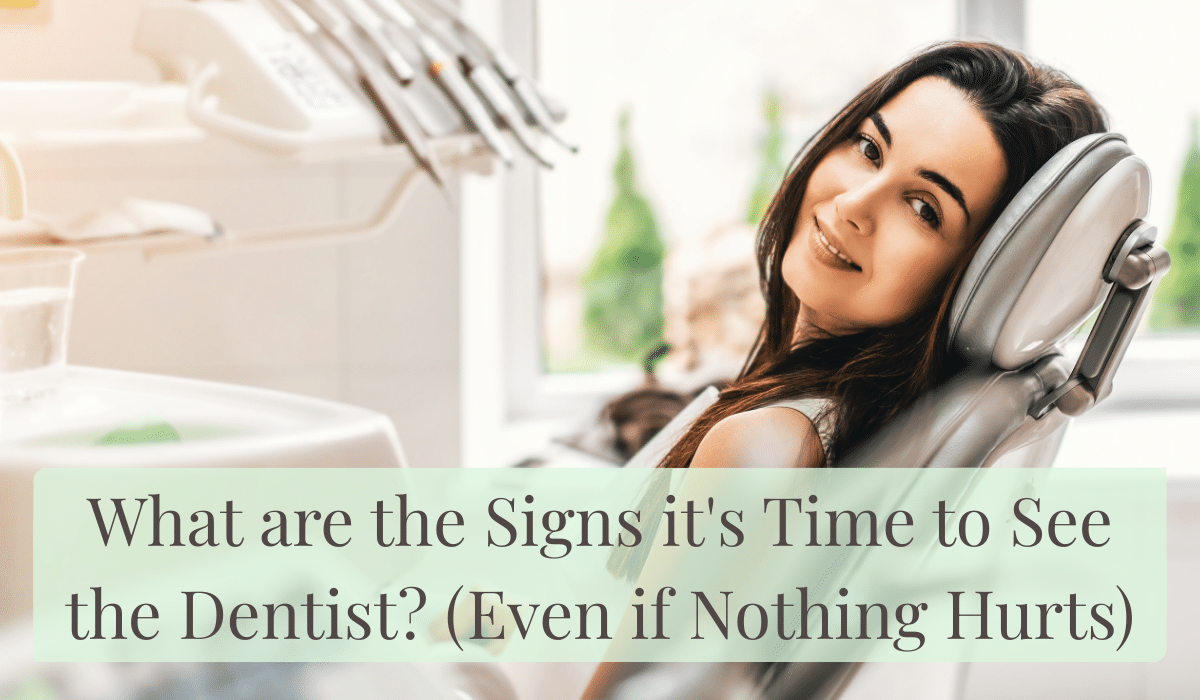Many people think that they only need to visit the dentist when they start experiencing pain, however, this approach to one’s oral health can lead to serious and expensive issues later. Oral pain often means that damage has already begun to occur. Some of the most serious oral health problems begin unnoticeably, often developing without the individual even being aware there’s a problem. Understanding the warning signs it’s time to see the dentist can help you prevent minor problems from developing into bigger issues.
Let’s take a look at the six signs it’s time to see the dentist, even if nothing hurts.
Sign #1: Bad Breath That Doesn’t Go Away
Persistent bad breath, also known as halitosis, can signal that there are oral health issues occurring, regardless of whether pain is present in the mouth or not. Temporary bad breath from consuming foods like onions, garlic, or coffee is normal, but chronic bad breath that doesn’t get better with the practice of good oral hygiene like brushing your teeth and flossing may mean there’s an underlying problem. This issue could be anything from gum disease to tooth decay to an oral infection of some sort. A reputable dentist in Kingwood can provide an examination that will determine what is causing your bad breath. Once the cause has been determined, the dentist can effectively treat the issues causing bad breath and restore your oral health.
Sign #2: Visible Changes to Your Teeth
Noticeable changes to your teeth can sometimes happen before pain occurs. This is why regularly examining your teeth can be important for catching early signs of problems. White spots, small dark spots, or changes in the color of your teeth can mean early stages of decay that are simpler and less costly to treat than a cavity that’s been left untreated for some time.
While a chip, crack, or rough edge on a tooth may not seem like a big deal at first, they can become worse as time passes and eventually allow bacteria to get inside the structure of the tooth. Taking care of these types of issues early can usually repair the damage with a simple procedure, whereas delaying treatment will likely require more substantial work.
Changes in the way your teeth fit together when you bite down, gaps showing up between your teeth, or teeth that are shifting from their original position can signal numerous issues including gum disease, teeth grinding, or other problems that would benefit from seeing your dentist sooner rather than later.
Sign #3: Changes in Your Gums
Healthy gums should look pink, be firm, and fit snug around each tooth. If your gums become red, sensitive to the touch, or puffy, this might mean early-stage gum disease (gingivitis) that needs professional help before symptoms get any worse.
Another warning sign that many people disregard as normal is bleeding gums. It may happen when someone brushes their teeth too aggressively, however, regular bleeding during an oral hygiene routine signals inflammation that needs professional examination by your dentist. If there is blood in the sink when brushing or when eating some foods, this could signal to gum disease that can develop into more serious problems without care.
Receding gums are where the gum line seems to be pulling away from the teeth, showing more of the surface of the tooth. Receding gums occur gradually over time and without pain. It can signal gum disease, poor brushing techniques, or other problems that require a dentist to prevent further complications and possible tooth loss.
Sign #4: Changes in the Tissues of Your Mouth
Any changes in the tissues of your mouth need to be seen by a dentist, even if they are painless. This includes white or red spots on your tongue, gums, or insides of your cheeks, sores that don’t get better within a couple weeks, or strange bumps or lumps anywhere in your mouth.
These changes could be indicators of anything from minor issues to more complicated and serious health issues. This speaks to the urgency of seeing a dentist every six months so they can examine the mouth, teeth and gums and catch any issues early on.
Sign #5: Sensitivity to Hot or Cold Drinks and Foods
Teeth sensitivity typically develops gradually and might seem manageable at first. However, it usually represents an early sign of tooth decay, worn enamel, or exposed tooth roots that will likely get worse if not addressed by a reputable dentist.
New sensitivity that occurs suddenly, even if it’s not severe, needs to be seen by a dentist to evaluate and address the cause.
Sign #6: Changes in Jaw Function and Bite Issues
Even without pain, changes in how your jaw functions can point to issues that need to be seen by a dentist. If you’re struggling to open your mouth fully, experiencing clicking or popping sounds when opening or closing your mouth, or having changes in how your teeth come together it may be a sign of temporomandibular disorder (TMD) or other problems.
Many people grind their teeth while sleeping, which can lead to bit issues. Signs of grinding your teeth include rough tooth surfaces, worn tips of teeth, or experiencing a stiff jaw in the morning. Bite issues typically occur gradually and don’t hurt immediately. These issues can lead to long-term damage of the teeth and jaw joints, so seeing a dentist for jaw or bite issues is important.
See a Reputable Kingwood Dentist for Optimal Oral Health
Don’t wait to be in pain before setting an appointment to see your dentist. Most dental issues progress slowly and without pain in the beginning. This is when treatment is most effective and the least costly. If you see any of the warning signs, schedule an appointment with your local Kingwood dentist and get your oral health back on track.
- How Can Cosmetic Dentistry Improve More Than Just Your Appearance? - December 5, 2025
- How to Choose the Best Shade for Veneers - October 8, 2025
- How Your Dentist Plans a Smile Makeover: Step-by-Step Guide to Your New Smile - September 2, 2025




